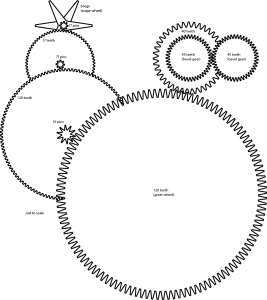It occurs to me I haven’t actually documented our going train yet. So here it is, complete with the unknowns.
Interestingly most of the Smith clocks I’ve looked at online have 100 teeth wheels where we have one of our 120s (the one that isn’t the great wheel). Unfortunately I don’t know what the rest of the train is like in those clocks because the pictures aren’t good enough to follow them through.
However, I’ve recently found one interesting clock that might be close to ours, at least for the going train. The clock at Trinity College Cambridge is a curious 1910 Smith clock with two striking trains. It first strikes the hour on one bell with one striking train, then again on a second bell with the second striking train. The site offers no explanation as to why it does this (except to say that the previous clock also did it). From the pictures it appears it has a 120 tooth wheel in the same position as ours and a 72 tooth wheel at the escapement. It has a 60 second rotation of the arbour, complete with dial and second hand. The pendulum length is stated as 2m, which is a bit odd (just short of 1.5 seconds), but there is mention of a 1.5 second swing in the explanation of the escapement. It appears to have a team of enthusiastic engineers looking after it so I’m optimistic I might get some useful info back if I make an inquiry… Update: unfortunately they didn’t reply at all.
